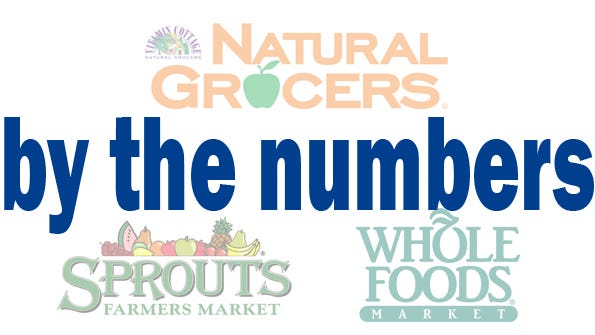
 Percentages, growth rates, margins and numbers galore have occupied us here at Natural Foods Merchandiser in recent weeks as we finally put our annual Market Overview edition to bed.
Percentages, growth rates, margins and numbers galore have occupied us here at Natural Foods Merchandiser in recent weeks as we finally put our annual Market Overview edition to bed.
This June issue soon will arrive in your mailbox, with concurrent posting to the web occurring. In it, you will find an intensive look at natural products retailing so that you can understand the whole picture but also benchmark your store against others like yours.
Interestingly, as we worked furiously to get all of these great charts on the page for your examination, two leading publicly traded natural chains released their quarterly numbers and another chain—Sprouts Farmers Market—announced its initial public offering intentions.
With these reports come even more interesting numbers highlighted here from the second-quarter earnings report from Whole Foods Market, Natural Grocers by Vitamin Cottage and Sprouts’ SEC Form S-1 and prospectus.
Total revenue
Whole Foods Market sales rose 13 percent to $3 billion. For the 28-week period that ended April 14, 2013, sales increased 14 percent to $6.9 billion.
Natural Grocers by Vitamin Cottage’s net sales increased 25.4 percent to $106.5 million in the second quarter and increased 26.6 percent to $202.3 million in the first half of fiscal 2013.
Sprouts reports sales of $2 billion in fiscal 2012, representing a 16 percent increase over 2011.
Comparable store sales
Whole Foods’ comparables increased 6.9 percent.
Natural Grocers reports 10.6 percent comparable store increases.
Sprouts reported in its prospectus combined comparable store sales growth of 9.7 percent in fiscal 2012.
Gross profit
Whole Foods’ gross profit reached 36.4 percent, driven by improved occupancy costs. Direct store expenses improved 14 basis points to 25.4 percent of sales primarily because of leverage in wages, health care costs and depreciation.
Natural Grocers’ gross profit during the second quarter of fiscal 2013 increased 23.9 percent. Gross margin decreased to 29.9 percent because of a shift in product mix toward products with slightly lower margins, partially offset by purchasing improvements. In addition, occupancy costs as a percentage of sales increased due to more expensive leases.
Growth plans
Whole Foods Market plans to triple its footprint to about 1,000 stores from the current 349, expecting to open three stores in the third quarter and 12 in the fourth. It also has signed 10 leases averaging 37,500 square feet for scheduled openings in fiscal 2014 and later.
Natural Grocers plans to open 13 stores in fiscal year 2013 and expects to relocate one and remodel two existing stores. It has signed leases for the remaining six stores planned to open in fiscal year 2013 and four stores planned to open in fiscal year 2014.
Sprouts' leadership believes the U.S. market can support approximately 1,200 Sprouts Farmers Market stores operating under the current format, including 300 in states in which it currently operates. It hopes to achieve 12 percent or more annual new store growth over at least the next five years with 19 openings planned for fiscal 2013 and approximately 20 store openings planned for fiscal 2014.
Bottom line strategies
Whole Foods Market: “We believe we will continue to gain market share as we accelerate our new store openings, improve our relative value proposition while maintaining our high quality standards, and further differentiate our shopping experience,” John Mackey, co-founder and co-chief executive officer, said via press release.
Natural Grocers: “We continue to experience stability in our comparable store sales, which we believe is a direct reflection of our commitment to affordable pricing, nutrition education and customer service,” Chairman, Director and Co-President Kemper Isely said during the quarterly report call.
Sprouts: noted two key strategies in its prospectus:
Continue to enhance our operating margins. We believe we can continue to enhance our operating margins though efficiencies of scale, improved systems, continued cost discipline and enhancements to our merchandise offerings. We have made significant investments in management, information technology systems, training, marketing, compliance and other infrastructure to enable us to pursue our growth plans, which we believe will also enhance our margins over time. Furthermore, we expect to achieve economies of scale in sourcing and distribution as we add new stores.
Grow the Sprouts Farmers Market brand. We are committed to supporting our stores, product offerings and brand through a variety of marketing programs, private label offerings and corporate partnerships. In addition, we will continue our community outreach and charity programs to more broadly connect with our local communities with the aim of promoting our brand and educating consumers on healthy choices. We will also continue to expand our innovative marketing and promotional strategy through print, digital and social media platforms, all of which promote our mission of “Healthy Living for Less.”
About the Author(s)
You May Also Like
.png?width=700&auto=webp&quality=80&disable=upscale)




